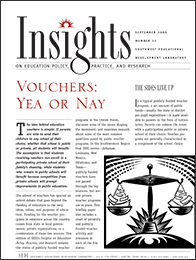Vouchers Add Costs
Voucher programs may bring high costs to public school systems. First, these systems are hit by the new costs of supporting an infrastructure for the voucher programs. Then, they may feel the effects of funds shifting from public to private schools.
Accountability demands could change the very nature of private schools, interfering with the missions that have made them a unique and valuable part of education in the United States.
Among new costs for school districts are those associated with administering and evaluating the public voucher program, verifying eligibility, record keeping, and developing information systems so parents can make the right choices for their children.
In the meantime, while voucher programs decrease the number of students that a public system has to educate, they do nothing to cut the cost of maintaining public schools in general. Schools must still pay big-ticket items such as transportation for voucher students. The latter, already a major expense in school budgets, becomes even bigger if districts must transport more students to private schools further away and across a wider geographic area.
In 1998-99, private schools in Milwaukee that accepted voucher students received $4,894 per student. This was a loss of $22 million to the public schools. That same year, the shift of funds from Cleveland schools to voucher schools was nearly $9 million. With additional transportation and administrative costs, the total costs rose to more than $10 million (National School Boards Association, 2000).
Where Do Dollars Go?
Other researchers have traced the flow of funds from local school districts to private schools. William Cooley (1991) of the University of Pittsburgh studied the likely flow of funds in a proposed Pennsylvania voucher program that was to provide $900 in credits for each student in the state. Because of the location of the participating private schools, Cooley found that two-thirds of the funds authorized from the plan would funnel into the eight counties with the highest per capita incomes, while none of the funds would go to the state’s poorest counties. In other words, his findings showed that tax dollars from poor counties would, in effect, support wealthy counties.
Researchers have also projected the costs to taxpayers of publicly funded voucher programs. Levin and Driver (1996) calculated that the cost of a voucher program that was open to all students and offered all the services that public schools provide—special education, bilingual education, vocational education, food services, transportation—would cost taxpayers almost $75 billion a year.
Comparisons Unjust
Levin also warns against comparing public school expenditures with private school tuition because private schools heavily supplement tuition with fund-raising events, fees for extra activities, and financial and in-kind contributions. In addition, religious organizations generally subsidize sectarian schools. Levin’s (1998) analysis of Milwaukee’s program indicates that private schools with voucher students received about $1,000 more per student than comparable public schools for the ’96—’97 school year. Milwaukee Public Schools allocated $3,469 per student in K—8 schools and $3,042 per student in elementary schools; private schools with voucher students received $4,373. Milwaukee had budgeted $7,628 per student but this figure included the cost of centralized services that private schools don’t have, and the higher cost of educating high school students, who are not included in the voucher program, so a school-based comparison was more appropriate, according to Levin.
For policymakers contemplating vouchers as a means of giving parents and students more educational choice, these findings raise a number of questions. What if the voucher isn't enough to cover tuition at the school of a family’s choice? Should parents be responsible for paying the remainder? Who is going to make up the difference in public school dollars?
Next Page: In Closing

